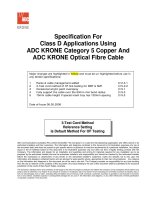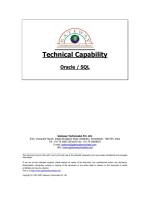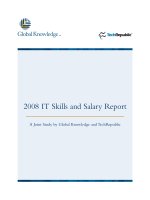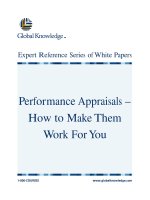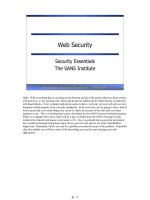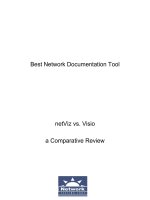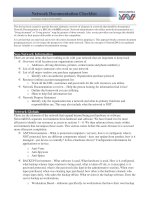Tài liệu Think Python doc
Bạn đang xem bản rút gọn của tài liệu. Xem và tải ngay bản đầy đủ của tài liệu tại đây (9.68 MB, 298 trang )
www.it-ebooks.info
www.it-ebooks.info
Allen B. Downey
Think Python
www.it-ebooks.info
ISBN: 978-1-449-33072-9
[LSI]
Think Python
by Allen B. Downey
Copyright © 2012 Allen Downey. All rights reserved.
Printed in the United States of America.
Published by O’Reilly Media, Inc., 1005 Gravenstein Highway North, Sebastopol, CA 95472.
O’Reilly books may be purchased for educational, business, or sales promotional use. Online editions are
also available for most titles (). For more information, contact our corporate/
institutional sales department: 800-998-9938 or
Editors: Mike Loukides and Meghan Blanchette
Production Editor: Rachel Steely
Proofreader: Stacie Arellano
Cover Designer: Karen Montgomery
Interior Designer: David Futato
Illustrators: Robert Romano and Rebecca Demarest
August 2012: First Edition
Revision History for the First Edition:
2012-08-03 First release
See for release details.
Nutshell Handbook, the Nutshell Handbook logo, and the O’Reilly logo are registered trademarks of O’Reilly
Media, Inc. Think Python, the image of a Carolina Parrot, and related trade dress are trademarks of O’Reilly
Media, Inc.
Many of the designations used by manufacturers and sellers to distinguish their products are claimed as
trademarks. Where those designations appear in this book, and O’Reilly Media, Inc., was aware of a trade
mark claim, the designations have been printed in caps or initial caps.
Think Python is available under the Creative Commons Attribution-NonCommercial 3.0 Unported License.
The author maintains an online version at />While every precaution has been taken in the preparation of this book, the publisher and authors assume
no responsibility for errors or omissions, or for damages resulting from the use of the information contained
herein.
www.it-ebooks.info
Table of Contents
Preface. . . . . . . . . . . . . . . . . . . . . . . . . . . . . . . . . . . . . . . . . . . . . . . . . . . . . . . . . . . . . . . . . . . . . . . xi
1.
The Way of the Program. . . . . . . . . . . . . . . . . . . . . . . . . . . . . . . . . . . . . . . . . . . . . . . . . . . . . . 1
The Python Programming Language 1
What Is a Program? 3
What Is Debugging? 4
Syntax Errors 4
Runtime Errors 4
Semantic Errors 5
Experimental Debugging 5
Formal and Natural Languages 6
The First Program 7
Debugging 8
Glossary 9
Exercises 11
2.
Variables, Expressions, and Statements. . . . . . . . . . . . . . . . . . . . . . . . . . . . . . . . . . . . . . . . 13
Values and Types 13
Variables 14
Variable Names and Keywords 15
Operators and Operands 16
Expressions and Statements 16
Interactive Mode and Script Mode 17
Order of Operations 18
String Operations 18
Comments 19
Debugging 19
Glossary 20
iii
www.it-ebooks.info
Exercises 21
3. Functions. . . . . . . . . . . . . . . . . . . . . . . . . . . . . . . . . . . . . . . . . . . . . . . . . . . . . . . . . . . . . . . . . 23
Function Calls 23
Type Conversion Functions 23
Math Functions 24
Composition 25
Adding New Functions 25
Definitions and Uses 27
Flow of Execution 27
Parameters and Arguments 28
Variables and Parameters Are Local 29
Stack Diagrams 30
Fruitful Functions and Void Functions 31
Why Functions? 32
Importing with from 32
Debugging 33
Glossary 33
Exercises 35
4.
Case Study: Interface Design. . . . . . . . . . . . . . . . . . . . . . . . . . . . . . . . . . . . . . . . . . . . . . . . . 37
TurtleWorld 37
Simple Repetition 38
Exercises 39
Encapsulation 40
Generalization 41
Interface Design 42
Refactoring 43
A Development Plan 44
Docstring 44
Debugging 45
Glossary 45
Exercises 46
5.
Conditionals and Recursion. . . . . . . . . . . . . . . . . . . . . . . . . . . . . . . . . . . . . . . . . . . . . . . . . . 49
Modulus Operator 49
Boolean Expressions 49
Logical Operators 50
Conditional Execution 50
Alternative Execution 51
Chained Conditionals 51
Nested Conditionals 52
iv | Table of Contents
www.it-ebooks.info
Recursion 53
Stack Diagrams for Recursive Functions 54
Infinite Recursion 55
Keyboard Input 55
Debugging 56
Glossary 57
Exercises 58
6.
Fruitful Functions. . . . . . . . . . . . . . . . . . . . . . . . . . . . . . . . . . . . . . . . . . . . . . . . . . . . . . . . . . 61
Return Values 61
Incremental Development 62
Composition 64
Boolean Functions 65
More Recursion 66
Leap of Faith 68
One More Example 68
Checking Types 69
Debugging 70
Glossary 71
Exercises 72
7.
Iteration. . . . . . . . . . . . . . . . . . . . . . . . . . . . . . . . . . . . . . . . . . . . . . . . . . . . . . . . . . . . . . . . . . 75
Multiple Assignment 75
Updating Variables 76
The while Statement 76
break 78
Square Roots 79
Algorithms 80
Debugging 81
Glossary 81
Exercises 82
8.
Strings. . . . . . . . . . . . . . . . . . . . . . . . . . . . . . . . . . . . . . . . . . . . . . . . . . . . . . . . . . . . . . . . . . . . 85
A String Is a Sequence 85
len 86
Traversal with a for Loop 86
String Slices 87
Strings Are Immutable 88
Searching 89
Looping and Counting 89
String Methods 90
The in Operator 91
Table of Contents | v
www.it-ebooks.info
String Comparison 92
Debugging 92
Glossary 94
Exercises 95
9. Case Study: Word Play. . . . . . . . . . . . . . . . . . . . . . . . . . . . . . . . . . . . . . . . . . . . . . . . . . . . . . . 97
Reading Word Lists 97
Exercises 98
Search 99
Looping with Indices 100
Debugging 102
Glossary 102
Exercises 103
10.
Lists. . . . . . . . . . . . . . . . . . . . . . . . . . . . . . . . . . . . . . . . . . . . . . . . . . . . . . . . . . . . . . . . . . . . . 105
A List Is a Sequence 105
Lists Are Mutable 106
Traversing a List 107
List Operations 107
List Slices 108
List Methods 108
Map, Filter, and Reduce 109
Deleting Elements 111
Lists and Strings 112
Objects and Values 112
Aliasing 113
List Arguments 114
Debugging 116
Glossary 117
Exercises 118
11.
Dictionaries. . . . . . . . . . . . . . . . . . . . . . . . . . . . . . . . . . . . . . . . . . . . . . . . . . . . . . . . . . . . . . 121
Dictionary as a Set of Counters 123
Looping and Dictionaries 124
Reverse Lookup 125
Dictionaries and Lists 126
Memos 128
Global Variables 129
Long Integers 130
Debugging 131
Glossary 132
vi | Table of Contents
www.it-ebooks.info
Exercises 133
12. Tuples. . . . . . . . . . . . . . . . . . . . . . . . . . . . . . . . . . . . . . . . . . . . . . . . . . . . . . . . . . . . . . . . . . . 135
Tuples Are Immutable 135
Tuple Assignment 136
Tuples as Return Values 137
Variable-Length Argument Tuples 137
Lists and Tuples 138
Dictionaries and Tuples 139
Comparing Tuples 141
Sequences of Sequences 142
Debugging 143
Glossary 144
Exercises 144
13. Case Study: Data Structure Selection. . . . . . . . . . . . . . . . . . . . . . . . . . . . . . . . . . . . . . . . . 147
Word Frequency Analysis 147
Random Numbers 148
Word Histogram 149
Most Common Words 150
Optional Parameters 151
Dictionary Subtraction 151
Random Words 152
Markov Analysis 153
Data Structures 154
Debugging 156
Glossary 157
Exercises 158
14.
Files. . . . . . . . . . . . . . . . . . . . . . . . . . . . . . . . . . . . . . . . . . . . . . . . . . . . . . . . . . . . . . . . . . . . . 159
Persistence 159
Reading and Writing 159
Format Operator 160
Filenames and Paths 161
Catching Exceptions 162
Databases 163
Pickling 164
Pipes 165
Writing Modules 166
Debugging 167
Glossary 168
Table of Contents | vii
www.it-ebooks.info
Exercises 169
15. Classes and Objects. . . . . . . . . . . . . . . . . . . . . . . . . . . . . . . . . . . . . . . . . . . . . . . . . . . . . . . . 171
User-Defined Types 171
Attributes 172
Rectangles 173
Instances as Return Values 174
Objects Are Mutable 175
Copying 176
Debugging 177
Glossary 178
Exercises 178
16. Classes and Functions. . . . . . . . . . . . . . . . . . . . . . . . . . . . . . . . . . . . . . . . . . . . . . . . . . . . . . 181
Time 181
Pure Functions 182
Modifiers 183
Prototyping Versus Planning 184
Debugging 185
Glossary 186
Exercises 187
17.
Classes and Methods. . . . . . . . . . . . . . . . . . . . . . . . . . . . . . . . . . . . . . . . . . . . . . . . . . . . . . . 189
Object-Oriented Features 189
Printing Objects 190
Another Example 191
A More Complicated Example 192
The init Method 192
The __str__ Method 193
Operator Overloading 194
Type-Based Dispatch 194
Polymorphism 196
Debugging 197
Interface and Implementation 197
Glossary 198
Exercises 199
18.
Inheritance. . . . . . . . . . . . . . . . . . . . . . . . . . . . . . . . . . . . . . . . . . . . . . . . . . . . . . . . . . . . . . . 201
Card Objects 201
Class Attributes 202
Comparing Cards 204
Decks 205
viii | Table of Contents
www.it-ebooks.info
Printing the Deck 205
Add, Remove, Shuffle, and Sort 206
Inheritance 207
Class Diagrams 209
Debugging 210
Data Encapsulation 211
Glossary 212
Exercises 213
19. Case Study: Tkinter. . . . . . . . . . . . . . . . . . . . . . . . . . . . . . . . . . . . . . . . . . . . . . . . . . . . . . . . 217
GUI 217
Buttons and Callbacks 218
Canvas Widgets 219
Coordinate Sequences 220
More Widgets 221
Packing Widgets 222
Menus and Callables 224
Binding 225
Debugging 227
Glossary 229
Exercises 230
A.
Debugging. . . . . . . . . . . . . . . . . . . . . . . . . . . . . . . . . . . . . . . . . . . . . . . . . . . . . . . . . . . . . . . 233
B.
Analysis of Algorithms. . . . . . . . . . . . . . . . . . . . . . . . . . . . . . . . . . . . . . . . . . . . . . . . . . . . . 243
C.
Lumpy. . . . . . . . . . . . . . . . . . . . . . . . . . . . . . . . . . . . . . . . . . . . . . . . . . . . . . . . . . . . . . . . . . . 255
Index. . . . . . . . . . . . . . . . . . . . . . . . . . . . . . . . . . . . . . . . . . . . . . . . . . . . . . . . . . . . . . . . . . . . . . . 265
Table of Contents | ix
www.it-ebooks.info
www.it-ebooks.info
Preface
The Strange History of This Book
In January 1999 I was preparing to teach an introductory programming class in Java. I
had taught it three times and I was getting frustrated. The failure rate in the class was
too high and, even for students who succeeded, the overall level of achievement was too
low.
One of the problems I saw was the books. They were too big, with too much unnecessary
detail about Java, and not enough high-level guidance about how to program. And they
all suffered from the trap door effect: they would start out easy, proceed gradually, and
then somewhere around Chapter 5 the bottom would fall out. The students would get
too much new material, too fast, and I would spend the rest of the semester picking up
the pieces.
Two weeks before the first day of classes, I decided to write my own book. My goals
were:
•
Keep it short. It is better for students to read 10 pages than not read 50 pages.
•
Be careful with vocabulary. I tried to minimize the jargon and define each term at
first use.
•
Build gradually. To avoid trap doors, I took the most difficult topics and split them
into a series of small steps.
•
Focus on programming, not the programming language. I included the minimum
useful subset of Java and left out the rest.
I needed a title, so on a whim I chose How to Think Like a Computer Scientist.
xi
www.it-ebooks.info
My first version was rough, but it worked. Students did the reading, and they understood
en
ough that I could spend class time on the hard topics, the interesting topics and (most
important) letting the students practice.
I released the book under the GNU Free Documentation License, which allows users
to copy, modify, and distribute the book.
What happened next is the cool part. Jeff Elkner, a high school teacher in Virginia,
ado
pted my book and translated it into Python. He sent me a copy of his translation,
and I had the unusual experience of learning Python by reading my own book. As Green
Tea Press, I published the first Python version in 2001.
In 2003 I started teaching at Olin College and I got to teach Python for the first time.
Th
e contrast with Java was striking. Students struggled less, learned more, worked on
more interesting projects, and generally had a lot more fun.
Over the last nine years I continued to develop the book, correcting errors, improving
s
ome of the examples and adding material, especially exercises.
The result is this book, now with the less grandiose title
Think Python. Some of the
c
hanges are:
• I added a section about debugging at the end of each chapter. These sections present
g
eneral techniques for finding and avoiding bugs, and warnings about Python
pitfalls.
• I added more exercises, ranging from short tests of understanding to a few sub
stantial projects. And I wrote solutions for most of them.
• I added a series of case studies—longer examples with exercises, solutions, and
di
scussion. Some are based on Swampy, a suite of Python programs I wrote for use
in my classes. Swampy, code examples, and some solutions are available from
http://
thinkpython.com.
• I expanded the discussion of program development plans and basic design patterns.
• I added appendices about debugging, analysis of algorithms, and UML diagrams
with Lumpy.
I hope you enjoy working with this book, and that it helps you learn to program and
think, at least a little bit, like a computer scientist.
—Allen B. Downey
Needham, MA
xii | Preface
www.it-ebooks.info
Acknowledgments
Many thanks to Jeff Elkner, who translated my Java book into Python, which got this
project started and introduced me to what has turned out to be my favorite language.
Thanks also to Chris Meyers, who contributed several sections to How to Think Like a
Computer Scientist.
Thanks to the Free Software Foundation for developing the GNU Free Documentation
License, which helped make my collaboration with Jeff and Chris possible, and Creative
Commons for the license I am using now.
Thanks to the editors at Lulu who worked on How to Think Like a Computer Scientist.
Thanks to all the students who worked with earlier versions of this book and all the
contributors (listed below) who sent in corrections and suggestions.
Contributor List
More than 100 sharp-eyed and thoughtful readers have sent in suggestions and correc
tions over the past few years. Their contributions, and enthusiasm for this project, have
been a huge help. If you have a suggestion or correction, please send email to feed
If I make a change based on your feedback, I will add you to
the contributor list (unless you ask to be omitted).
If you include at least part of the sentence the error appears in, that makes it easy for
me to search. Page and section numbers are fine, too, but not quite as easy to work with.
Thanks!
•
Lloyd Hugh Allen sent in a correction to Section 8.4.
•
Yvon Boulianne sent in a correction of a semantic error in Chapter 5.
•
Fred Bremmer submitted a correction in Section 2.1.
•
Jonah Cohen wrote the Perl scripts to convert the LaTeX source for this book into beautiful HTML.
•
Michael Conlon sent in a grammar correction in Chapter 2 and an improvement in style in Chapter
1, and he initiated discussion on the technical aspects of interpreters.
•
Benoit Girard sent in a correction to a humorous mistake in Section 5.6.
•
Courtney Gleason and Katherine Smith wrote horsebet.py, which was used as a case study in an
earlier version of the book. Their program can now be found on the website.
•
Lee Harr submitted more corrections than we have room to list here, and indeed he should be listed
as one of the principal editors of the text.
•
James Kaylin is a student using the text. He has submitted numerous corrections.
Preface | xiii
www.it-ebooks.info
• David Kershaw fixed the broken catTwice function in Section 3.10.
• Eddie Lam has sent in numerous corrections to Chapters 1, 2, and 3. He also fixed the Makefile so
that it creates an index the first time it is run and helped us set up a versioning scheme.
• Man-Yong Lee sent in a correction to the example code in Section 2.4.
•
David Mayo pointed out that the word “unconsciously” in Chapter 1 needed to be changed to
“subconsciously.”
•
Chris McAloon sent in several corrections to Sections 3.9 and 3.10.
• Matthew J. Moelter has been a long-time contributor who sent in numerous corrections and sug
gestions to the book.
• Simon Dicon Montford reported a missing function definition and several typos in Chapter 3. He
also found errors in the increment function in Chapter 13.
• John Ouzts corrected the definition of “return value” in Chapter 3.
• Kevin Parks sent in valuable comments and suggestions as to how to improve the distribution of the
book.
• David Pool sent in a typo in the glossary of Chapter 1, as well as kind words of encouragement.
• Michael Schmitt sent in a correction to the chapter on files and exceptions.
• Robin Shaw pointed out an error in Section 13.1, where the printTime function was used in an
example without being defined.
•
Paul Sleigh found an error in Chapter 7 and a bug in Jonah Cohen’s Perl script that generates HTML
from LaTeX.
•
Craig T. Snydal is testing the text in a course at Drew University. He has contributed several valuable
suggestions and corrections.
•
Ian Thomas and his students are using the text in a programming course. They are the first ones to
test the chapters in the latter half of the book, and they have made numerous corrections and
suggestions.
•
Keith Verheyden sent in a correction in Chapter 3.
•
Peter Winstanley let us know about a longstanding error in our Latin in Chapter 3.
•
Chris Wrobel made corrections to the code in the chapter on file I/O and exceptions.
•
Moshe Zadka has made invaluable contributions to this project. In addition to writing the first draft
of the chapter on Dictionaries, he provided continual guidance in the early stages of the book.
•
Christoph Zwerschke sent several corrections and pedagogic suggestions, and explained the differ
ence between gleich and selbe.
•
James Mayer sent us a whole slew of spelling and typographical errors, including two in the con
tributor list.
• Hayden McAfee caught a potentially confusing inconsistency between two examples.
xiv | Preface
www.it-ebooks.info
• Angel Arnal is part of an international team of translators working on the Spanish version of the
text. He has also found several errors in the English version.
• Tauhidul Hoque and Lex Berezhny created the illustrations in Chapter 1 and improved many of the
other illustrations.
•
Dr. Michele Alzetta caught an error in Chapter 8 and sent some interesting pedagogic comments
and suggestions about Fibonacci and Old Maid.
•
Andy Mitchell caught a typo in Chapter 1 and a broken example in Chapter 2.
• Kalin Harvey suggested a clarification in Chapter 7 and caught some typos.
•
Christopher P. Smith caught several typos and helped us update the book for Python 2.2.
• David Hutchins caught a typo in the Foreword.
• Gregor Lingl is teaching Python at a high school in Vienna, Austria. He is working on a German
translation of the book, and he caught a couple of bad errors in Chapter 5.
• Julie Peters caught a typo in the Preface.
• Florin Oprina sent in an improvement in makeTime, a correction in printTime, and a nice typo.
• D. J. Webre suggested a clarification in Chapter 3.
• Ken found a fistful of errors in Chapters 8, 9 and 11.
•
Ivo Wever caught a typo in Chapter 5 and suggested a clarification in Chapter 3.
•
Curtis Yanko suggested a clarification in Chapter 2.
•
Ben Logan sent in a number of typos and problems with translating the book into HTML.
•
Jason Armstrong saw the missing word in Chapter 2.
•
Louis Cordier noticed a spot in Chapter 16 where the code didn’t match the text.
•
Brian Cain suggested several clarifications in Chapters 2 and 3.
•
Rob Black sent in a passel of corrections, including some changes for Python 2.2.
•
Jean-Philippe Rey at Ecole Centrale Paris sent a number of patches, including some updates for
Python 2.2 and other thoughtful improvements.
•
Jason Mader at George Washington University made a number of useful suggestions and corrections.
•
Jan Gundtofte-Bruun reminded us that “a error” is an error.
•
Abel David and Alexis Dinno reminded us that the plural of “matrix” is “matrices”, not “matrixes.”
This error was in the book for years, but two readers with the same initials reported it on the same
day. Weird.
•
Charles Thayer encouraged us to get rid of the semi-colons we had put at the ends of some statements
and to clean up our use of “argument” and “parameter.”
•
Roger Sperberg pointed out a twisted piece of logic in Chapter 3.
•
Sam Bull pointed out a confusing paragraph in Chapter 2.
Preface | xv
www.it-ebooks.info
• Andrew Cheung pointed out two instances of “use before def.”
• C. Corey Capel spotted the missing word in the Third Theorem of Debugging and a typo in
Chapter 4.
• Alessandra helped clear up some Turtle confusion.
•
Wim Champagne found a brain-o in a dictionary example.
•
Douglas Wright pointed out a problem with floor division in arc.
•
Jared Spindor found some jetsam at the end of a sentence.
• Lin Peiheng sent a number of very helpful suggestions.
• Ray Hagtvedt sent in two errors and a not-quite-error.
• Torsten Hübsch pointed out an inconsistency in Swampy.
• Inga Petuhhov corrected an example in Chapter 14.
• Arne Babenhauserheide sent several helpful corrections.
• Mark E. Casida is is good at spotting repeated words.
• Scott Tyler filled in a that was missing. And then sent in a heap of corrections.
• Gordon Shephard sent in several corrections, all in separate emails.
• Andrew Turner spotted an error in Chapter 8.
•
Adam Hobart fixed a problem with floor division in arc.
•
Daryl Hammond and Sarah Zimmerman pointed out that I served up math.pi too early. And Zim
spotted a typo
.
•
George Sass found a bug in a Debugging section.
•
Brian Bingham suggested Exercise 11-10.
•
Leah Engelbert-Fenton pointed out that I used tuple as a variable name, contrary to my own advice.
And then found a bunch of typos and a “use before def.”
•
Joe Funke spotted a typo.
•
Chao-chao Chen found an inconsistency in the Fibonacci example.
•
Jeff Paine knows the difference between space and spam.
•
Lubos Pintes sent in a typo.
•
Gregg Lind and Abigail Heithoff suggested Exercise 14-4.
•
Max Hailperin has sent in a number of corrections and suggestions. Max is one of the authors of the
extraordinary Concrete Abstractions, which you might want to read when you are done with this
book.
•
Chotipat Pornavalai found an error in an error message.
•
Stanislaw Antol sent a list of very helpful suggestions.
xvi | Preface
www.it-ebooks.info
• Eric Pashman sent a number of corrections for Chapters 4–11.
• Miguel Azevedo found some typos.
• Jianhua Liu sent in a long list of corrections.
• Nick King found a missing word.
•
Martin Zuther sent a long list of suggestions.
•
Adam Zimmerman found an inconsistency in my instance of an “instance” and several other errors.
•
Ratnakar Tiwari suggested a footnote explaining degenerate triangles.
• Anurag Goel suggested another solution for is_abecedarian and sent some additional corrections.
And he knows how to spell Jane Austen.
• Kelli Kratzer spotted one of the typos.
• Mark Griffiths pointed out a confusing example in Chapter 3.
• Roydan Ongie found an error in my Newton’s method.
• Patryk Wolowiec helped me with a problem in the HTML version.
• Mark Chonofsky told me about a new keyword in Python 3.
• Russell Coleman helped me with my geometry.
•
Wei Huang spotted several typographical errors.
•
Karen Barber spotted the the oldest typo in the book.
•
Nam Nguyen found a typo and pointed out that I used the Decorator pattern but didn’t mention it
by name.
•
Stéphane Morin sent in several corrections and suggestions.
•
Paul Stoop corrected a typo in uses_only.
•
Eric Bronner pointed out a confusion in the discussion of the order of operations.
•
Alexandros Gezerlis set a new standard for the number and quality of suggestions he submitted. We
are deeply grateful!
•
Gray Thomas knows his right from his left.
•
Giovanni Escobar Sosa sent a long list of corrections and suggestions.
•
Alix Etienne fixed one of the URLs.
•
Kuang He found a typo.
•
Daniel Neilson corrected an error about the order of operations.
•
Will McGinnis pointed out that polyline was defined differently in two places.
•
Swarup Sahoo spotted a missing semi-colon.
• Frank Hecker pointed out an exercise that was under-specified, and some broken links.
•
Animesh B helped me clean up a confusing example.
Preface | xvii
www.it-ebooks.info
• Martin Caspersen found two round-off errors.
• Gregor Ulm sent several corrections and suggestions.
xviii | Preface
www.it-ebooks.info
CHAPTER 1
The Way of the Program
The goal of this book is to teach you to think like a computer scientist. This way of
thinking combines some of the best features of mathematics, engineering, and natural
science. Like mathematicians, computer scientists use formal languages to denote ideas
(specifically computations). Like engineers, they design things, assembling components
into systems and evaluating tradeoffs among alternatives. Like scientists, they observe
the behavior of complex systems, form hypotheses, and test predictions.
The single most important skill for a computer scientist is problem solving. Problem
solving means the ability to formulate problems, think creatively about solutions, and
express a solution clearly and accurately. As it turns out, the process of learning to
program is an excellent opportunity to practice problem-solving skills. That’s why this
chapter is called, “The way of the program.”
On one level, you will be learning to program, a useful skill by itself. On another level,
you will use programming as a means to an end. As we go along, that end will become
clearer.
The Python Programming Language
The programming language you will learn is Python. Python is an example of a high-
level language; other high-level languages you might have heard of are C, C++, Perl,
and Java.
There are also low-level languages, sometimes referred to as “machine languages” or
“assembly languages.” Loosely speaking, computers can only run programs written in
low-level languages. So programs written in a high-level language have to be processed
before they can run. This extra processing takes some time, which is a small disadvantage
of high-level languages.
1
www.it-ebooks.info
The advantages are enormous. First, it is much easier to program in a high-level lan
guage. Programs written in a high-level language take less time to write, they are shorter
and easier to read, and they are more likely to be correct. Second, high-level languages
are portable, meaning that they can run on different kinds of computers with few or no
modifications. Low-level programs can run on only one kind of computer and have to
be rewritten to run on another.
Due to these advantages, almost all programs are written in high-level languages. Low-
level languages are used only for a few specialized applications.
Two kinds of programs process high-level languages into low-level languages:
interpreters and compilers. An interpreter reads a high-level program and executes it,
meaning that it does what the program says. It processes the program a little at a time,
alternately reading lines and performing computations. Figure 1-1 shows the structure
of an interpreter.
Figure 1-1. An interpreter processes the program a little at a time, alternately reading lines
and performing computations.
A compiler reads the program and translates it completely before the program starts
running. In this context, the high-level program is called the source code, and the
translated program is called the
object code or the executable. Once a program is com
piled, you can execute it repeatedly without further translation. Figure 1-2 shows the
structure of a compiler.
Figure 1-2. A compiler translates source code into object code, which is run by a hardware
executor.
Python is considered an interpreted language because Python programs are executed
by an interpreter. There are two ways to use the interpreter: interactive mode and script
mode
. In interactive mode, you type Python programs and the interpreter displays the
result:
2 | Chapter 1: The Way of the Program
www.it-ebooks.info
>>> 1 + 1
2
The chevron, >>>, is the prompt the interpreter uses to indicate that it is ready. If you
type 1 + 1, the interpreter replies 2.
Alternatively, you can store code in a file and use the interpreter to execute the contents
of the file, which is called a script. By convention, Python scripts have names that end
with
.py.
To execute the script, you have to tell the interpreter the name of the file. If you have a
script named
dinsdale.py and you are working in a UNIX command window, you type
python dinsdale.py. In other development environments, the details of executing
scripts are different. You can find instructions for your environment at the Python web
site .
Working in interactive mode is convenient for testing small pieces of code because you
can type and execute them immediately. But for anything more than a few lines, you
should save your code as a script so you can modify and execute it in the future.
What Is a Program?
A program is a sequence of instructions that specifies how to perform a computation.
The computation might be something mathematical, such as solving a system of equa
tions or finding the roots of a polynomial, but it can also be a symbolic computation,
such as searching and replacing text in a document or (strangely enough) compiling a
program.
The details look different in different languages, but a few basic instructions appear in
just about every language:
input:
Get data from the keyboard, a file, or some other device.
output:
Display data on the screen or send data to a file or other device.
math:
Perform basic mathematical operations like addition and multiplication.
conditional execution:
Check for certain conditions and execute the appropriate code.
repetition:
Perform some action repeatedly, usually with some variation.
What Is a Program? | 3
www.it-ebooks.info
Believe it or not, that’s pretty much all there is to it. Every program you’ve ever used, no
matter how complicated, is made up of instructions that look pretty much like these. So
you can think of programming as the process of breaking a large, complex task into
smaller and smaller subtasks until the subtasks are simple enough to be performed with
one of these basic instructions.
That may be a little vague, but we will come back to this topic when we talk about
algorithms.
What Is Debugging?
Programming is error-prone. For whimsical reasons, programming errors are called
bugs and the process of tracking them down is called debugging.
Three kinds of errors can occur in a program: syntax errors, runtime errors, and se
mantic errors. It is useful to distinguish between them in order to track them down more
quickly.
Syntax Errors
Python can only execute a program if the syntax is correct; otherwise, the interpreter
displays an error message.
Syntax refers to the structure of a program and the rules
about that structure.For example, parentheses have to come in matching pairs, so
(1 + 2) is legal, but 8) is a syntax error.
In English readers can tolerate most syntax errors, which is why we can read the poetry
of e. e. cummings without spewing error messages. Python is not so forgiving. If there
is a single syntax error anywhere in your program, Python will display an error message
and quit, and you will not be able to run your program. During the first few weeks of
your programming career, you will probably spend a lot of time tracking down syntax
errors. As you gain experience, you will make fewer errors and find them faster.
Runtime Errors
The second type of error is a runtime error, so called because the error does not appear
until after the program has started running. These errors are also called
exceptions
because they usually indicate that something exceptional (and bad) has happened.
Runtime errors are rare in the simple programs you will see in the first few chapters, so
it might be a while before you encounter one.
4 | Chapter 1: The Way of the Program
www.it-ebooks.info
Semantic Errors
The third type of error is the semantic error. If there is a semantic error in your program,
it will run successfully in the sense that the computer will not generate any error mes
sages, but it will not do the right thing. It will do something else. Specifically, it will do
what you told it to do.
The problem is that the program you wrote is not the program you wanted to write. The
meaning of the program (its semantics) is wrong. Identifying semantic errors can be
tricky because it requires you to work backward by looking at the output of the program
and trying to figure out what it is doing.
Experimental Debugging
One of the most important skills you will acquire is debugging. Although it can be
frustrating, debugging is one of the most intellectually rich, challenging, and interesting
parts of programming.
In some ways, debugging is like detective work. You are confronted with clues, and you
have to infer the processes and events that led to the results you see.
Debugging is also like an experimental science. Once you have an idea about what is
going wrong, you modify your program and try again. If your hypothesis was correct,
then you can predict the result of the modification, and you take a step closer to a
working program. If your hypothesis was wrong, you have to come up with a new one.
As Sherlock Holmes pointed out, “When you have eliminated the impossible, whatever
remains, however improbable, must be the truth.” (A. Conan Doyle,
The Sign of Four)
For some people, programming and debugging are the same thing. That is, program
ming is the process of gradually debugging a program until it does what you want. The
idea is that you should start with a program that does something and make small mod
ifications, debugging them as you go, so that you always have a working program.
For example, Linux is an operating system that contains thousands of lines of code, but
it started out as a simple program Linus Torvalds used to explore the Intel 80386 chip.
According to Larry Greenfield, “One of Linus’s earlier projects was a program that would
switch between printing AAAA and BBBB. This later evolved to Linux.” (
The Linux
Users’ Guide Beta Version 1).
Later chapters will make more suggestions about debugging and other programming
practices.
Semantic Errors | 5
www.it-ebooks.info


